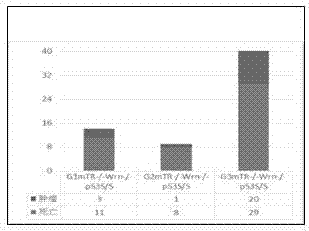Application of P53 gene mutation and telomere dysfunction
A technology of abnormal function and telomeres, applied in the biological field, can solve the serious problems such as the course of the disease, and achieve the effect of good scientific significance and clinical application value
- Summary
- Abstract
- Description
- Claims
- Application Information
AI Technical Summary
Problems solved by technology
Method used
Image
Examples
Embodiment 1
[0019] Embodiment 1: Construction of polycystic kidney animal model
[0020] p53S mice with WS ( mTR - / - Wrn - / - ) mice were crossed to obtain an animal model of polycystic kidney disease; Human Progeria Syndrome (Werner Syndrome, WS) is an autosomal recessive mutation genetic disease, which manifests as obvious premature aging and shortened lifespan. Studies on the etiology of WS have found that WS is caused by mutations in the Wrn gene. The WRN protein encoded by the Wrn gene belongs to the DNA helicase RecQ family and is involved in DNA replication, recombination and DNA damage repair, so it plays a key role in maintaining the stability of chromosomes. Loss of Wrn protein function itself can lead to abnormal DNA replication at telomeres. Therefore, the WS mouse model is a good model for us to study the mechanism of abnormal telomere function and the occurrence and maintenance of human aging. In order to confirm that the abnormal function of telomere is the key to pr...
Embodiment 2
[0024] Example 2: mTR - / - Wrn - / - p53 S / S Mouse genotyping
[0025] Twenty-one days after birth, the offspring were divided into cages according to the sex of the mice. At the same time, number the mice, cut the tail of the mouse about 1 cm, and extract the mouse DNA. The DNA extraction process is as follows:
[0026] 1) Add 500 μL Tail-lysis buffer and 10 μL proteinase K to the Doff tube containing the mouse tail, mix well and put it in a 55°C incubator to react overnight;
[0027] 2) Add 500 μL Tris-saturated phenol to the Doff tube for protein extraction;
[0028] 3) Centrifuge at 13000rpm for 10min at 4°C;
[0029] 4) Transfer about 400 μL of the supernatant to another clean Doff tube, and add an equal volume of isopropanol;
[0030] 5) Centrifuge at 13000rpm at 4°C for 10 minutes, discard the supernatant;
[0031] 6) Add 1mL of pre-cooled 70% alcohol to the Doff tube;
[0032] 7) Centrifuge at 13000rpm at 4°C for 10 minutes, discard the supernatant;
[0033]...
Embodiment 3
[0067] Example 3: Statistics on the incidence of tumors in mice of different generations
[0068] During the breeding process of mice, it was recorded as a case that tumors were found in mice. in G1 mTR - / - Wrn - / - p53 S / S In the mouse population, a total of 11 mice died of aging, among which 3 mice died of tumors; G2 mTR - / - Wrn - / - p53 S / S In the mouse population, 8 mice died of aging, including 1 mouse that died of tumor; G3 mTR - / - Wrn - / - p53 S / S In the mouse population, 29 mice died of aging, among which 20 mice died of tumors, which is the tumor incidence rate of mice of different generations ( figure 2 ).
PUM
 Login to View More
Login to View More Abstract
Description
Claims
Application Information
 Login to View More
Login to View More - R&D
- Intellectual Property
- Life Sciences
- Materials
- Tech Scout
- Unparalleled Data Quality
- Higher Quality Content
- 60% Fewer Hallucinations
Browse by: Latest US Patents, China's latest patents, Technical Efficacy Thesaurus, Application Domain, Technology Topic, Popular Technical Reports.
© 2025 PatSnap. All rights reserved.Legal|Privacy policy|Modern Slavery Act Transparency Statement|Sitemap|About US| Contact US: help@patsnap.com



